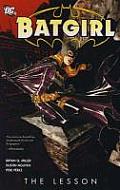Stephanie Brown: The Final Fight
 The last weekly Robin closed with a hint that it was actually good that the Robin storyline titled The Final Fight, scripted by Chuck Dixon, was never produced.
The last weekly Robin closed with a hint that it was actually good that the Robin storyline titled The Final Fight, scripted by Chuck Dixon, was never produced.
That’s not because Fabian Nicieza’s Search for a Hero was stellar. (I thought Nicieza was kept from exercising his fine understanding of the character of Tim Drake because of difficult scheduling.) And it’s certainly not because that canceled volume would have impeded Tony Daniel’s Battle for the Cowl.
Rather, the key to that sentiment rests in how DC Comics’s description of that volume concluded: “Robin also has his hands full with a not-so-happy family reunion between his lady love [Spoiler] and her father, Cluemaster!”
Dixon created Stephanie Brown, the Spoiler, as an antagonist for the Cluemaster, a second-rate Riddler introduced in 1966. When fans wanted to see more of her, Dixon wrote stories of Stephanie as Tim’s other woman, then his main girlfriend. But since Tim was the protagonist of those stories, Stephanie mainly posed problems for him: a crush on her when he was seeing someone else, her pregnancy, her father moving back in, her replacing him as Robin, her temporary death, and so on. Stephanie was, as TV Tropes said, a walking Afterschool Special of teen woes.
The Final Fight description promises further adventures in that mode. It describes Robin with “his hands full” once again because of Spoiler and Cluemaster. And as the protagonist in his own magazine, Tim Drake would have once again helped to fix Stephanie’s troubles for her.
But being the child of a minor supervillain was Stephanie’s problem, not Tim’s. So the cancellation of this Robin storyline meant that problem was available to Bryan Q. Miller to address in his Batgirl series, collected in three volumes: Batgirl Rising, The Flood, and The Lesson.
As Miller was telling his stories, Christopher Yost and Nicieza were showing Tim Drake fighting crime overseas and in cyberspace. That left Stephanie with the challenges that Dixon used to give Tim in Robin: trying to keep up the life of a normal Gotham City student while also fighting powerful criminals. So Stephanie has to deal with midterms, campus crime, a teenage witch-boy, and a suspicious mom.
It’s clear that Miller had to shape his storytelling around some editorial mandates. Barbara Gordon gets yanked out of the action when DC needed her to appear in another series. Another supporting character, Wendy from Teen Titans, is just settling in when she suddenly disappears. One issue in the last volume was written to set up an issue of Batman Incorporated that wasn’t even published until months later. But the series’ overall narrative arc stands up to all that.
Like Nicieza in his second opportunity with Tim Drake, Miller had to finish his run much faster than he planned to make room for DC’s reboot. I thought Nicieza’s climactic storyline suffered from being crammed into one issue, but Miller was able to overcome that problem. In a terrific last issue, he simultaneously showed Stephanie confronting her oldest problem—her dad, of course—and looking ahead to possible glorious futures. And she achieves those triumphs for herself.
It would still have been possible for Tim and Stephanie to confront the Cluemaster in Dixon’s Final Fight and for her later to confront him again in her own magazine. Parental issues never go away, after all. But for Stephanie Brown to come of age, she had to be more than support for another title character. Tim makes some appearances in Batgirl, but the much more significant crossovers of this period are when Stephanie appears in Red Robin, showing him how she can stand on her own.
In DC’s rebooted universe, Stephanie Brown’s role—and even existence—is uncertain. She was never a Robin, even briefly. It’s unclear whether she was ever Batgirl. Her larger story for all practical purposes appears to be over.
COMING UP: But that may not be a bad thing.




No comments:
Post a Comment